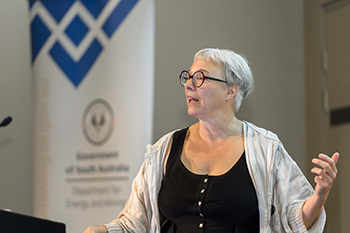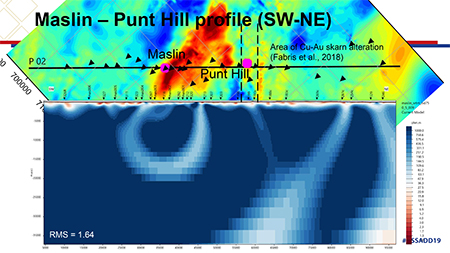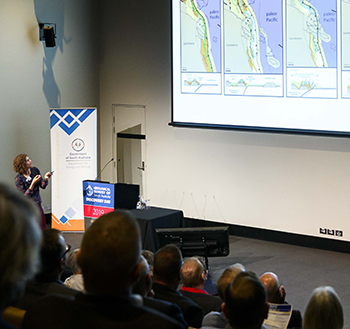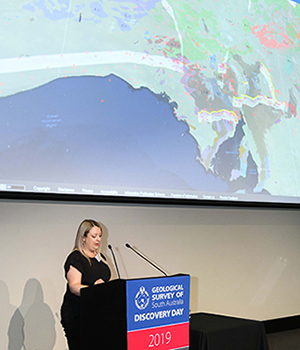Vibrant geoscience illuminates path to discovery.
The Geological Survey of South Australia’s Discovery Day 2019 lived up to its reputation as the state’s premier forum for cutting-edge geoscience.
A full-house of 300 delegates heard from a line-up of engaging speakers who explored the day's themes - New geoscience, Ancient and modern environments, and Digital earth.
Newly appointed Director of the Geological Survey of South Australia, Rohan Cobcroft, shared his intent to build on South Australia’s leading geological expertise.
‘Precompetitive data is key to riding through the ups and downs of commodity cycles, and being able to leverage off data on the path to discovery continues to be our priority,’ Rohan said.

Dr Louise Corriveau’s expertise in IOCG systems was in high demand with her giving keynote presentations at both Discovery Day and the subsequent Iron oxide – copper–gold Mineral Systems Workshop.
The morning session cemented South Australia as a leading province for iron oxide – copper–gold (IOCG) mineral systems, with talks by national and international experts in the field, including Dr Louise Corriveau, research scientist with the Geological Survey of Canada. She challenged delegates to rethink geological models of the IOCG systems in our state. Louise has developed a system of categorising various mineral assemblages for IOCG-type mineral deposits that geologists can use to understand how near or far they may be to an ore deposit based on the minerals present in drillhole samples.
New geoscience

Example MT profile across Maslin – Punt Hill shown by Dr Stephan Thiel in his presentation on ‘Mineral systems mapping in the Olympic Domain’ (PDF 6.8 MB).
The GSSA's Dr Stephan Thiel shared his results of the state’s prospective eastern Gawler Craton from magnetotellurics (MT) and related modelling.
South Australian geoscientists have built world-class capability in MT technique – which is proving ideal in highlighting our state’s IOCG systems to help guide explorers to where ore bodies might lie. The survey’s latest release is arguably the most detailed publicly available study of a mineral system in the world using electromagnetic methods.
Stephan walked delegates through the MT infill work over a 100 by 100 km zone involving MT stations spaced at between 1.5 and 3 km across the Olympic Domain. The zone encompasses areas such as Maslin, Mount Gunson, Carrapateena to Emmie Bluff, Oak Dam, Punt Hill and more along the eastern Gawler Craton.
The work was complemented by an airborne electromagnetic survey to characterise geological cover. It was then integrated into state-of-the-art 2D and 3D modelling with other datasets to reveal a step change in resolution in mapping the crustal IOCG mineral systems at camp-scale.
Not only has the modelling shown remarkable accuracy to predict known ore bodies, but it has highlighted areas of raised prospectivity in the region, opening up the possibility of new areas for discovery.
Adrian Fabris discussed the survey’s brief to speed up discovery. Achieving cut-through will come from improving the ability to:
- recognise significant ore systems
- better predict where mineral systems might occur
- deliver industry data as quickly and easily as possible.
In depth analysis of geophysical data in the eastern Gawler Craton shows that 96% of known IOCG occurrences lie within 1 km radius of a magnetic high with a coincident gravity anomaly. Cluster analysis and prospectivity modelling can be used to further refine geophysical features and identify prospective ground.
Geochemical characterisation of South Australia’s known IOCG occurrences by the survey has shown that IOCG mineralisation has a particular signature that explorers can use to not only identify this style of mineralisation, but also recognise distinct characteristics of large deposits.
Part of characterising IOCG systems involves making use of the detailed downhole mineral signatures generated by the HyLogger core scanning system – available on the South Australia Resource Information Gateway (SARIG). The survey is on a mission to collect as many representative drill core and rock samples as possible. Together with the stock of previous samples collected and scanned at the South Australia Drill Core Reference Library, they are well on the way with BHP setting a great example by supplying a local reference set of samples. A work in progress is to enable quick and easy access to relevant data by building a portal – the IOCG knowledge cube.
Dr Caroline Tiddy, a MinEX CRC collaborator with the University of South Australia, provided a new way to link the state’s IOCG systems to deeper tectonic models. Her interpretations provide clues on where new mineral deposits might be found.
Delamerian in focus

Delegates were given insights into discovering what lies beneath the Murray Basin in Stacey Curtis’s ‘Plate margin tectonics and metallogeny of the Delamerian Orogen’ (PDF 4.3 MB) presentation.
South Australia’s involvement with the MinEx CRC is now focused on the National Drilling Initiative. The survey’s Stacey Curtis gave an excellent expose on understanding the Delamerian Orogen of eastern South Australia ahead of a planned drilling program in 2020. She was joined by Dr Sandra McLaren, a leading researcher from the University of Melbourne, and the survey’s Dr Baohong Hou who delved into the geology of the Murray Basin. This region, one of the world’s largest preserved Cenozoic shoreline systems is prospective for mineral sands and other commodities. The Cambrian to Ordovician rocks beneath the Murray Basin cover are largely untapped, but are prospective for gold, copper, silver, nickel, platinum group elements, lead, zinc, molybdenum, tin and more.
Digital earth
Globally there is an insatiable appetite for exploration data. The survey’s Ursula Michael outlined international efforts to achieve open data standards to enable big data analytics to thrive. The major drive to enable the coherent exchange of information is key to attracting the global exploration community to unlock South Australia’s resources with ease.

Data delivery was the theme of Ursula Michael’s presentation ‘Enabling big data analytics in geoscience through open data standards’ (PDF 5.2 MB).
Holly Bridgwater of Unearthed enlarged on the current trends in data science and its application to mineral exploration. Following Discovery Day, the Minister for Energy and Mining announced Unearthed will be the project partner to run the government’s global crowdsourcing competition – Explore SA: The Gawler Challenge.
Providing inspiration, Qufeng Shi of DeepsightX and an Associate Professor with the Australian Institute for Machine Learning, University of Adelaide, shared various applications across industry sectors, and the principles behind artificial intelligence that can be used to locate mineral resources.
Also featured were presentations on the scope of the Accelerated Discovery Initiative by Mineral Resources Director Alex Blood and a session devoted to understanding the geology of the Flinders Ranges.
The survey thanks partners MinEx CRC and the University of South Australia for showcasing their Project Live virtual reality experience in the exhibition area. The South Australian Museum assisted with an eye-catching geological time walk, which featured rock and fossil specimens from the main geological time periods.
Discovery Day presentations are available for download.
– Grace Taylor and Anthony Reid, December 2019


